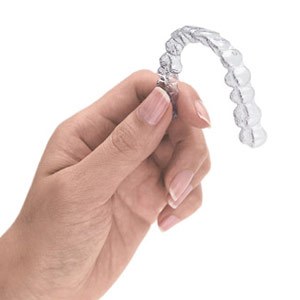INVISALIGN®



Braces for Adults and Teens
According to invisalign® 2000 survey, 74% of American women and men believe that an attractive smile is important for getting their dream job, while 84% fell it is critical for their love lives. invisalign® can give you the beautiful straight teeth you’ve always wanted. It works through a series of invisible, removable, and comfortable aligners that no one can tell you’re wearing. You can smile during treatment as well as after.

What is invisalign®?
invisalign® can help you get the great smile you’ve always wanted because it’s…
- Invisible, so no one can tell you’re straightening your teeth. So now you can smile more during treatment as well as after.
- Removable, so you can eat and drink what you want while in treatment, plus brushing and flossing are no problem.
- Comfortable, because it has no metal to cause mouth abrasions during treatment. And no metal and wires usually means you spend less time in your doctor’s office getting adjustments.
invisalign® also allows you to view your own virtual treatment plan when you start, so you can see how your straight teeth will look when your treatment is complete.
- Is the invisible way to straighten your teeth without braces.
- Aided by computer imagery uses a series of clear removable aligners to straighten your teeth without metal wires or brackets.
- Has been proven effective in clinical research.
How Does invisalign® Work?
- You wear each set of aligners for about 2 weeks, removing them only to eat, drink, brush, and floss. Each set of aligners, move the teeth about 0.25 millimeters per aligner
- As you replace each aligner with the next in the series, your teeth will move – little by little, week by week – until they have straightened to the final position.
- You’ll visit your dentist about once every 6 weeks to ensure that your treatment is progressing as planned.
- Total treatment time averages 9-15 months and the average number of aligners worn during treatment is between 18 and 30, but both will vary from case to case.
How Are Aligners Made? You’d Be Amazed…
The aligners are made using a combination of your orthodontist’s or dentist’s expertise and 3-D computer imaging technology.
As part of invisalign®, You will be required to have these things:
- full mouth vinyl polysiloxane impression
- completed records – panoramic/FMX x-ray
- intra-oral photographs
- extra-oral photographs
Traditional Orthodontics versus The invisalign Technique:
| Traditional Orthodontics | invisalign | |
|---|---|---|
| Materials | Wires and brackets | Clear plastic trays “aligners” |
| Type of Treatment | Broad range of orthodontic therapy | Most suitable for patients with certain orthodontic needs Suitability |
| Suitability | Suitable for many patients | Suited mainly for a vast majority of adults and for adolescents who have their permanent teeth. |
invisalign’s distinct advantage is to give you the great smile you have always wanted:
- Invisible, so no one can tell you are straightening your teeth. So now you can smile more DURING treatment as well as after.
- Removable, so you can eat and drink what you want while in treatment, plus brushing and flossing are no problem.
- Comfortable, because it has no metal to cause mouth abrasions during treatment. And no metal and wires means you spend less time in your doctor’s office getting adjustments.
- Oral hygiene is improved
- invisalign allows you to view your own virtual treatment plan when you start, so you can see how your straight teeth will look when you treatment is complete.
- May reduce the risk of cavities and gum disease when compared to wire braces that trap food and plaque.
- Visit dentist only 1x every 6 weeks
- Is usually faster than conventional braces
- No metal braces
- In most cases the aligners are doing multiple tooth movements simultaneously. Commonly, in conventional bracketing, some movements get ignored until another movement is completed by the current mechanics
- Work usually completed in 15 months conventional braces takes an average of 2 years
Disadvantages of invisalign:
- They are “not designed to treat patients with mixed dentition, changing a bite and/or growing palates and therefore are not appropriate for children.”
- All restorative work must be completed before or after the treatment.
- Designed to treat patients with less complex orthodontic needs.
- It is difficult to change this system after treatment has begun because this system is so exacting.
- The system is dependent on the patient wearing the retainers. May temporarily affect your speech. They are to be worn full time, day or night, except while eating and brushing or flossing. Teeth may be sore with a slight ache from the pressure especially for the first few days with each new set of aligners.
- After the work is completed you must wear a retainer at night – as with any type of orthodontic treatment, if you don’t wear your retainers then teeth will move.
- Need for good patient compliance.
- Cash or financing up front is needed in order to assure that you will wear the aligners
Dentistry has moved beyond just treating the teeth and oral cavity. Dentists can now give patients beautiful faces and alleviate a multitude of medical problems.
Benefits of braces for adults:
- Reduce decay and gum disease due to crowding
- Relieve headaches and earaches
- Improve speaking, biting or chewing problems
- Prevent or improve TMD troubles
Disadvantage of braces in adulthood is that they take longer than teenagers. The average adult wears braces for 18 months to 3 years. Braces are custom-made appliances that use gentle pressure to straighten teeth and bite. This straightening process can cause discomfort. However, invisalign can reduce the length of time a patients is required to wear braces to 18 months or less. In addition, many patients find aligners more comfortable than braces.
Remember that while wearing braces keep your teeth and brackets clean to reduce the risk of cavities. Avoid hard foods such as candy, raw carrots, corn on the cob, pretzels, nuts, popcorn and crushed ice because they will damage or dislodge braces. Avoid sticky foods to decrease your risk of cavities.
How do I adjust to life with braces?
You probably will experience some discomfort or difficulty speaking or eating at first. While wearing braces, keep your teeth and brackets clean. If you wear cemented, non-removable braces, food and plaque can get trapped between teeth and gums. To reduce your risk of cavities, follow a regimen of brushing, flossing and rinsing, and reduce your consumption of sweets and carbohydrates. Plaque and sugar combine to make acid, which can cause decalcification (white spots) on teeth and tooth decay if left behind.
Which foods should I avoid?
It’s a good idea not to eat foods that can damage or dislodge braces. Hard foods such as candy, raw carrots, corn on the cob, pretzels, nuts, popcorn and crushed ice are off limits. Sticky foods to avoid include caramel, taffy and gum. These foods can get stuck between teeth and gums or bend wires and knock bands or brackets loose. If eating these foods results in damage to braces, treatment may be extended.
Do I need to see my dentist during orthodontic treatment?
Yes. Remember that going to the orthodontist is not a substitute for regular dental checkups. If you’re going to invest time and financial resources in a healthy smile, be prepared to go the distance to achieve results. That means you should consult your dentist for a schedule that’s appropriate for you.
No matter your age, it is never too late to improve your dental health and beautify your smile because more adults are wearing braces.

